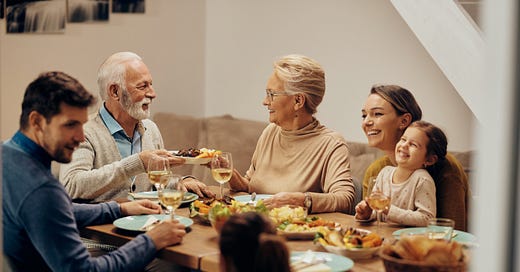Yet Another Sign of Encouragement in this "Golden Age of America"
In times of confusing turmoil as we are now experiencing, on top of decades of societal devolution and the unraveling of the moral fabric of our society, the disappointment and discouragement can contribute to losing hope, and a paralysis that can contribute to us “lowering the bar” yet again. But as “hope springs eternal,” and we don’t give up, it is essential to acknowledge and highlight positive changes whenever and wherever they come from. Sometimes they are very subtle.
I happened to run across an article by yahoo!life reporter, Rebecca Corey, last week entitled, “Can the open-concept floor plan impact mental health? Why the home trend popularized by HGTV may be on the way out.” A voice inside my head screamed, “Yes!” I had not given it a lot of thought before, but in the first couple of years of my college career my major was architecture, before I fell “madly” in love with psychology. I remember being fascinated with the dynamic of how human beings are so affected by their surroundings, yet, at the same time also create their surroundings based on their present emotional and mental state. One does not have to go far to observe how ugly the field of architecture and art have become over the last 60 years, and don’t even get me started on the automobile industry.
In Corey’s article, she stated:
“While open floor plans came into fashion in the 1950s, Tanisha Lyons-Porter, a professional organizer states, “they really took off in the 1990s and 2000s. These designs were intended to create a more fluid, casual living space by eliminating walls that traditionally separated rooms like the living room, dining room and kitchen.” The appeal was clear: Fewer barriers made homes feel larger, brighter and more inclusive, allowing for better flow between areas.”
What could be wrong with that? The last couple of times that my wife and I looked for a house, we were in awe of the open concept, and repeatedly stated, “Wouldn’t this be great for parties?” Maybe, but how often do we have a large party? And back to architecture, what is the function of the building, and who is it designed for?
It helps to keep in mind that we are discussing a “first world” problem, and historically, up until the 20th century, most people lived in one room houses or cabins, with maybe a drape covered alcove for a sleeping area. Today, most people in the United States live better than most kings and queens throughout history. However, I believe most people in the United States are also more stressed and overwhelmed than most populations throughout most of history.
Stress reduction has been an increasing goal for most of my clients. The complaint, “I’m feeling overwhelmed,” is most likely shared with the majority of our present population. The mental and physical illnesses that have resulted from this chronic stress has been catastrophic. But back to the “light at the end of the tunnel,” and no, it’s not a train.
In her article, Corey also quoted “A survey done by Rocket Homes in 2021 that found that more than 51% of Americans preferred homes with an open layout, and nearly 49% preferred a traditional layout,” and that “open floors may be falling out of favor.”
Let me explain why this is a positive trend in our society and for the mental health of the individual, especially within the context of a marriage and the family. Another common theme that comes up in counseling are “healthy boundaries” in relationships. I am also continually encouraging my clients in this overwhelming world we live in to learn how to better “compartmentalize” and prioritize, with the end goal that the individual, marriage, and family will be able to “function” more effectively. There is no shortage of research which demonstrates how ineffective and dysfunctional “multi-tasking” is.
So, you see, the mere fact that our society is trending towards a healthier design, in order to be able to experience healthier, functional relationships within that design structure, is a very good sign. And as we better compartmentalize the function of our healthy families, we can build a stronger sense of trust, security, and definition of all the different and important aspects of our busy lives. When we sit down for dinner as a family, there is presently nothing else more important than what we are sharing with each other than what is occurring right now in this dining room. No TV, no phones, and no distractions.
My wife and I hosted a large family party a few weeks ago with about 25 people. There were a few people in the den checking out “the game” on TV. There were also the usual suspects hanging out in the kitchen, and a lively group huddled around the dining room table. My favorite room was the living room which had an entirely different, and comfortable feel to it. No stress, no overwhelm, just a happy family gathering. My hope is that this trend continues.





